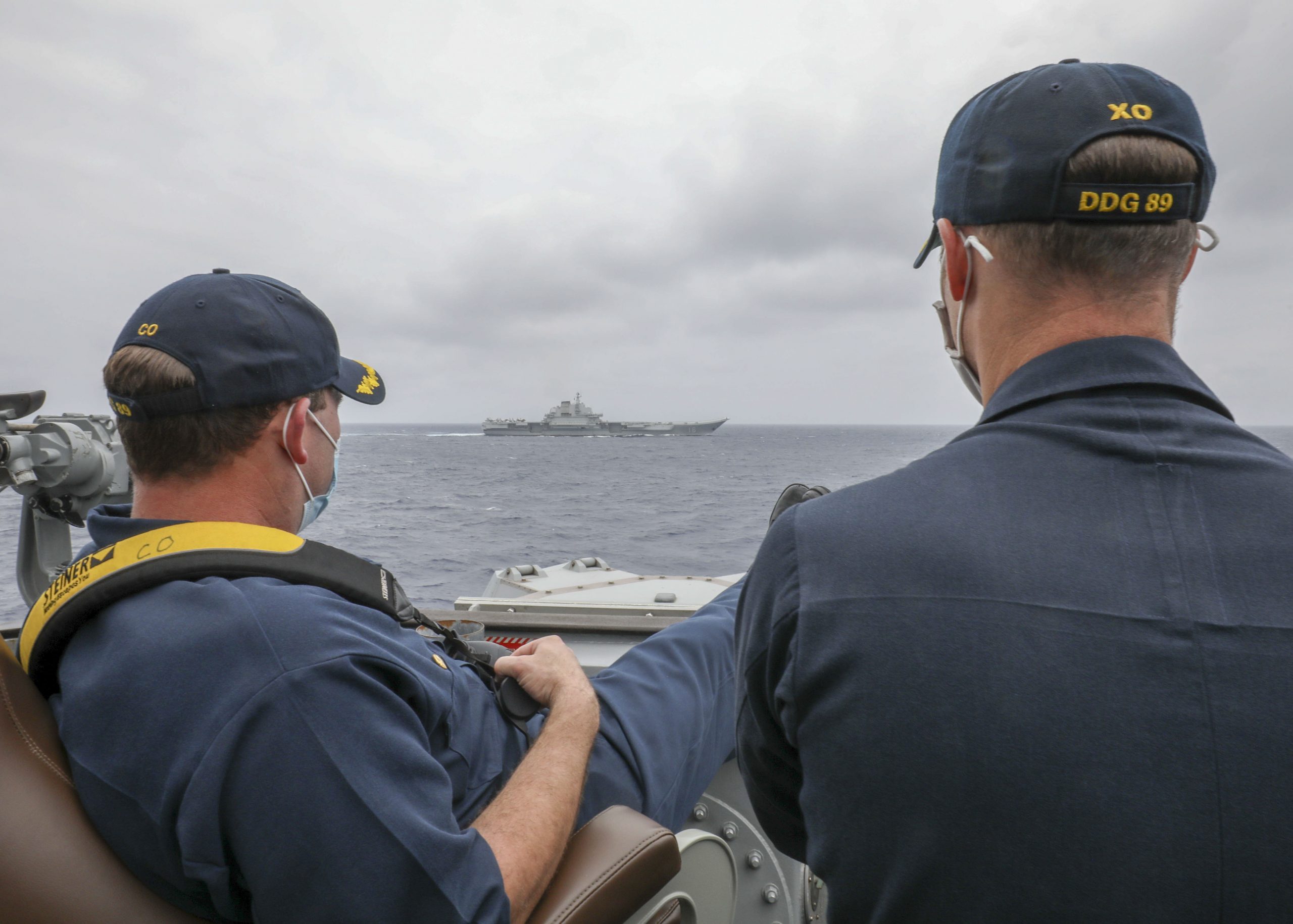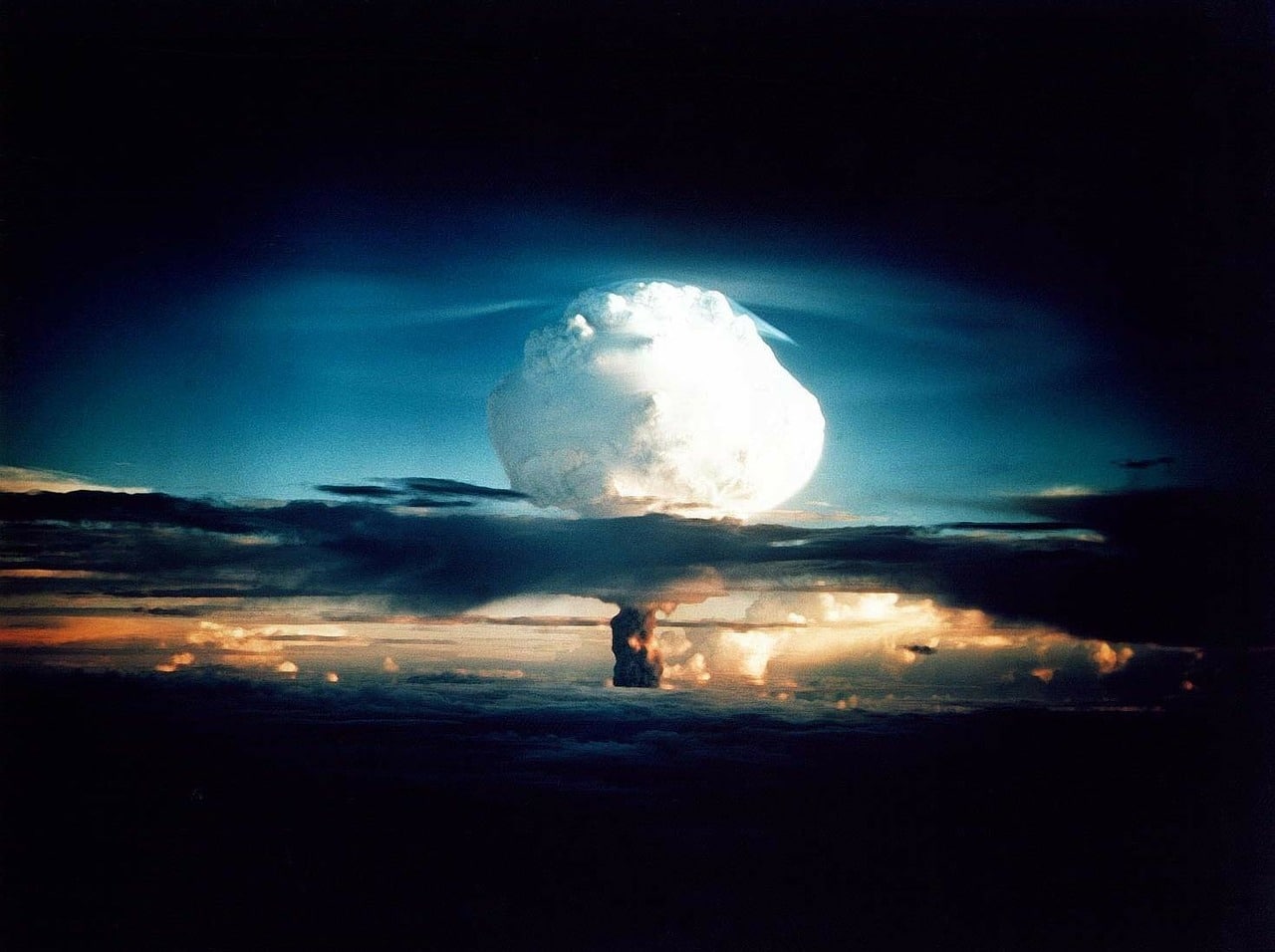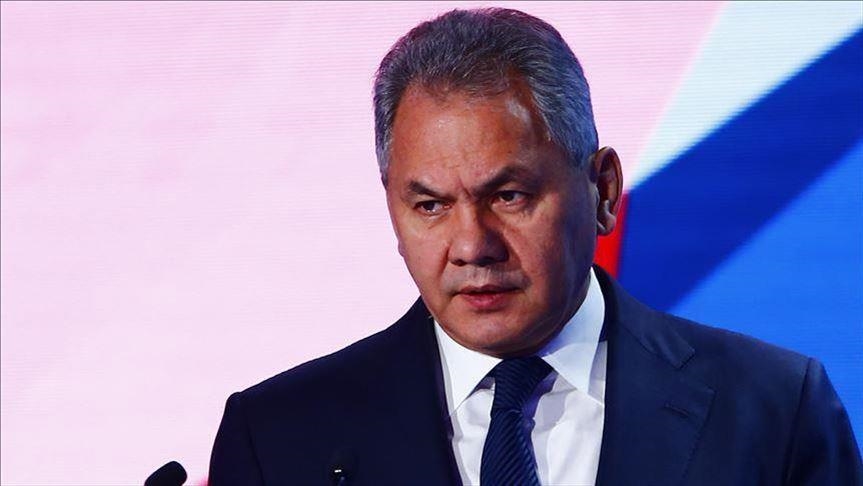The latest flare-up in the geopolitical standoff over Ukraine is a feature, not a bug, of Washington’s most recent grand narrative of global affairs.
The names of these grand narratives read more like B-list action titles than mass-murder campaigns: From the production team who brought you “The Red MENACE,” the “War on Terror,” and “Counterinsurgency,” the foreign policy establishment is proud to present: “Renewed Power Competition.”
Admittedly, this installment’s title doesn’t quite have the same boom! to it. But for you action fans out there, never fear, its implications and the policies it attempts to justify are much more—explosive than its predecessors.
The term has its genesis in James Mattis’ 2018 National Defense Strategy, which announced “inter-state strategic competition, not terrorism, is now the primary concern in U.S. national security.”
In its summary, Mattis breaks the West’s foes into two categories: “revisionist powers” China and Russia, and “rogue regimes” Iran and North Korea. He accuses these nations of employing “increased efforts short of armed conflict by expanding [their] coercion to new fronts, violating principles of sovereignty, exploiting ambiguity, and deliberately blurring the lines between civil and military goals.”
Of course, the U.S. currently employs all the above tactics, in addition to armed conflict—a fact so far from the mind of the average American, it may as well be fictional.
Mattis laments that the U.S. no longer enjoys “uncontested or dominant superiority in every operating domain,” stating “[t]oday, every domain is contested—air, land, sea, space, and cyberspace.” Clearly, the echoes of Manifest Destiny continued on to reverberate across the globe.
In much the same way that Counterinsurgency lacked a clear definition of victory, it is unclear what exactly Competition means. In fact, there is no officially accepted definition for the term: neither the U.S. military interagency, the Department of Defense, nor partner nations have uniformly defined it.
This is a hallmark of a military without ethical or moral justification. In the only just theory of military action, immediate self-defense, the objective is clear: repel the invaders. Instead, the Joint Chiefs of Staff must grope with something called the “Competition Continuum,” which just sounds like the Tri-Lamb’s strategy for winning the Greek Games in Revenge of the Nerds.
But the reality of Renewed Power Competition is America’s dead hand grasp at absolute global empire after its decades-long mass murder/suicide against a military tactic.
When Mattis says that “every domain is contested,” he is really saying that Russia may take exception to the presence of U.S. and NATO military installations and forces on its door step.
For instance, in April 2021, Russian News Agency TASS reported NATO’s plans to concentrate “40,000 troops and 15,000 items of armament and military hardware near Russian borders” in the Black Sea and Baltic Regions. This included the deployment of “U.S. force groupings” in Poland and the Baltic states.” Further, Russian Defense Minister Sergei Shoigu claimed the NATO alliance “annually holds up to 40 large operational training measures of a clearly anti-Russia bias in Europe.”
The largest of such training measures is DefenderEurope, an annual US-led war NATO war game. This year’s iteration began in March and is planned to last until June 2021. Involving at least 31,000 soldiers from 27 nations, it promises to be the largest military exercise since the Cold War, despite continued COVID-19 restrictions. These forces will conduct “nearly simultaneous operations across more than 30 training areas in a dozen countries … over a wider area than what was planned for in 2020.”
The U.S. Army proclaimed the purpose of the war games in a statement that can only be aimed at Russia:
Defender-Europe 21 is evidence of the ironclad U.S. commitment to NATO, is a prime example of our collective capabilities, and demonstrates that NATO allies and partners stand stronger together.
Another such exercise is the intrepidly-titled “Trojan Footprint 21,” which began May 2, 2021. Touted as the Pentagon’s Special Operations Command-Europe’s “premier Special Operations Force exercise,” the operation aims to “train and build interoperability” between the U.S. Army, Air Force, and Naval special operations forces. The war game is taking place across “Romania and Europe” with allied partners to include Bulgaria, Germany, Georgia, Montenegro, North Macedonia, Spain, Ukraine, and the United Kingdom.” Bridging on self-parody, commanding officer Col. Marc V. LaRoche declared the operation’s intent: to “promote peace and stability throughout Europe.”
As Antiwar.com Contributing Editor Rick Rozoff commented: although the operation’s ostensible purpose is to counter “myriad threats” in the region, there exists only one true enemy: one that has a naval fleet stationed at Sevastopol in Crimea. The Defender-Europe 21 war game comes on the heels of Crystal Arrow 2021, another U.S.-led NATO war game. Rick Rozoff again writes:
As regards the launching of the Crystal Arrow exercise on March 23, the NATO report waxed lively: “U.S. Abrams tanks joined German Leopard tanks to race across the open field marking the start of an eight-day exercise at the Ādaži military training area, Latvia…”
It would have to have been the very archetype of Cold War nightmare themes among Russians in the Soviet Union to see American and German tanks on their border. Now they’re right there. And not alone.
The prospect of an American and German-led invasion of Russia is the apex of Washington’s commitment to Orwellian gaslighting (but we’ve always been at war with Eastasia).
When it comes to aerial dominance, Mattis really means that China, Russia, and Iran prefer US sorties not toe their sovereign airspace.
In September 2020, a Beijing-based think tank claimed the US flew “at least 60 warplanes near China’s coast.” In February, 2021, U.S. a reconnaissance plane flirted with the same airspace as a sortie of Chinese warplanes. More recently, on May 14, 2021, the U.S. Navy announced the deployment of two MQ-4C Triton drones from Guam to Northern Japan, the first such deployment of high-altitude long endurance unmanned aerial vehicles (HALE-UAVs) to Japan. According to the South China Morning Post, these UAVs were first deployed to the Pacific last year, when they were sent to Guam. Since then, they have:
carried out surveillance missions around China, including over the Taiwan Strait and People’s Liberation Army (PLA) bases along the coast, and near to Beijing’s military facilities on artificial islands in the South China Sea, according to open-source aviation monitoring data.
Meanwhile, on May 19, 2021, A Russian SU-27 fighter jet shadowed an American B-52N strategic bomber over the Baltic Sea, preventing what it claimed would otherwise have been an “unauthorized incursion” into Russian airspace. The confrontations are commonplace, occurring in the Arctic, the Black Sea, Northeast Asia, the Baltic Sea, and the Middle East.
As if these confrontations were not harrowing enough, the U.S. chose to honor its war dead by demonstrating its willingness to multiply their numbers. On Memorial Day 2021, US B52H bombers flew over all 30 NATO nations in an ostensible effort to “demonstrate the credibility of [NATO] forces to address a global security environment that is more diverse and uncertain than at any time in our history.” By comedic providence, the aerial farce was deployed from Moron Air Base in Spain.
A view from USS Squall as 2x IRGCN FIAC quickly approach USCGC Maui during a transit in the Strait of Hormuz May 10.
During the interaction, IRGCN vessels came within 150 yds of Maui at high speed, an unnecessarily close range that put the ships & their crews in danger. pic.twitter.com/h6edFGal4E
— U.S. 5th Fleet (@US5thFleet) May 10, 2021
By sea, Mattis means Iran might not appreciate the US Coast guard patrolling the Strait of Hormuz and firing warning shots at Iranian cutters. Likewise, China may not appreciate U.S. warships’ regular passage through the Taiwan Strait or U.S. Navy missile destroyers shadowing its aircraft carriers in the South China Sea.
Likewise, in eastern Europe, Russia certainly does not enjoy the presence of guided-missile cruisers and destroyers in the Black Sea. This is especially true when their presence runs concurrent with the largest NATO military exercise since the Cold War. Such is the case with the above-mentioned Operation Trojan Footprint.
By space, Mattis is referring to that amorphous area of international commons which the 1967 UN General Assembly declared to be the “province of all mankind.” So much for that.
And of course, by cyberspace–well we just have to take the word of the U.S. “intelligence” community that foreign hackers regularly attack US infrastructure and “democratic” institutions—for instance ignoring the fact that SolarWind’s password was “solarwinds123” and was publicly available online.

In the South China Sea, US officers watch the Liaoning, a Chinese aircraft carrier from the deck of the Mustin (US Navy photo by Mass Communication Specialist 3rd Class Arthur Rosen) Additional Credit Antiwar.com
Despite the disharmonic translation of think tank puffery into actual cohesive strategy, the U.S. Empire’s Renewed Power Competition certainly looks like escalation and not deterrence. Thus, it is not surprising that Congress’ foreign policy briefings are crafted within its escalatory framework.
To illustrate: the Congressional Research Service (“CRS”), the body that serves “as a shared staff to congressional committees and Members of Congress,” has issued a series of reports to guide policy within this narrative. First published in at least August 2018, the report was last updated March 4, 2021, a little over a month before the height of U.S.—Russian tensions over Ukraine.
It is unclear what direct influence this report has garnered amongst military and civilian policy makers, however, the U.S. military is certainly emulating its core directives. And that makes sense—Congressional Research Service “experts assist at every stage of the legislative process–from the early considerations that precede bill drafting though committee hearings and floor debate, to the oversight of enacted laws and various agency activities.” (Emphasis Supplied).
Hinting even further at the Report’s pedigree is the fact that it was picked up by the Council on Foreign Relations and linked on its “Ukraine” quick facts page.
Again, the sterile title—“Renewed Power Competition: Implications for Defense–Issues for Congress,”—obscures the Report’s alarming policy directives. Chief among them is to update America’s nuclear weapons arsenal–part of an ongoing multi-billion-dollar plan to “modernize U.S. strategic nuclear deterrent forces” to stay ahead of Russia and China’s. This effort includes acquiring “a new class of ballistic missile submarines and a next-generation long-range bomber.” This objective should frighten those Americans whose pocketbooks still mourn the Air Force’s ongoing F-35 debacle.
Second is a continuation the Obama administration’s “Pivot to Asia,” a redeployment of the nation’s military forces “so as to place more emphasis on deployments for countering Chinese and, secondarily, Russian military capabilities, and less emphasis on deployments that serve other purposes.” Of course, this includes a writ-large expansion of NATO’s capabilities in Eastern Europe and an expansion of the Navy’s operations in both the Black Sea and the Indo-Pacific.
This pivot has put the U.S. foreign policy establishment in the absurd position of fitting a King-sized bed with a sheet meant for a Twin.
On Sunday, March 23, CENTCOM Commander General Frank McKenzie illustrated just that when he warned the AP that the global influence of Russia and China will grow if the U.S. focuses its military assets solely on their doorsteps–a real Catch-22. How does one maintain the Empire’s outposts abroad whilst confronting the Huns at their own gates?

U.S. Marine Gen. Frank McKenzie (AP Photo/Lolita C. Baldor)
Clearly, the only solution is to get a bigger, more flexible bed sheet—that is to increase global U.S. military presence and capabilities indefinitely and infinitely. This is the exact aim of Renewed Power Competition: the self-licking ice cream cone.
In lockstep with this goal, the CRS Report also documents the US military’s emphasis on deploying military assets to the Indo-Pacific. Specifically, the Navy’s deployment of its “most capable ships, aircraft, and personnel to the region,” for “increased operations, exercises, and warfighting experiments.” Its focus will be the development of new weapon systems and technologies. The primary aim being to prepare for “potential future operations in the region.”
Another given example is the Marine Corps’ restructuring plan, entitled “Force Design 2030” which is “driven primarily by a need to better prepare [it] for potential operations against Chinese forces in a conflict in the Western Pacific.” In true Marine esprit de corps, the shift is spun as a triumphant return to the Marine Corps’ original theater of operations and tactics.
The Longer Telegram, a paper published by The Atlantic Council, laid out this renewed vision of the Marine Corps:
… the Marines will be resolutely sea-based and able to sail into the waters of the South China Sea, well inside the island chains China relies on for defense. Once inside, they will use armed drones, offensive cyber capabilities, Marine Raiders — highly capable special forces — anti-air missiles and even ship-killer strike weapons to attack Chinese maritime forces, and perhaps even their land bases of operations. The Chinese militarized artificial islands in the South China Sea would be juicy targets, for example. In essence, this will be guerrilla warfare from the sea.
Returning to the CRS Report, the immediate purpose of these “New Operational Concepts” is “countering improving Chinese anti-access/area-denial military forces in the Indo-Pacific area.”
What do average Americas care if China has more influence around the South China Sea? It should be self-evident from the above paragraph that China’s military strategy in the Indo-Pacific is to deny American access to its backyard, or at the least charitable, territory in its neighborhood.
Furthermore, Americans could do without one of the most terrifying prongs of a so-called Renewal of Great Power Competition—“High End Conventional Warfare.”
Indeed, the CRS defines this to mean “large-scale, high-intensity, technologically sophisticated conventional warfare against adversaries with similarly sophisticated military capabilities.” This is a perfect illustration of the infamous words of Madeline Albright: “What’s the point in having this sophisticated military that you’re always talking about if we can’t use it?”
Aside from the very real threat of nuclear armageddon, perhaps the most alarming aspect of Great Power Competition is the U.S.’s “Mobilization Capabilities for Extended-Length Conflict” against China or Russia. In other words, total war.
As articulated in the CRS Report, its prospects are grisly and impersonal:
- inducting and training additional military personnel to expand the size of the force or replace personnel who are killed or wounded;
- producing new weapons to replace those expended in the earlier stages of a conflict;
- repairing battle damage to ships, aircraft, and vehicles;
- replacing satellites or other support assets that are lost in combat; and
- manufacturing spare parts and consumable items.
Underlining the establishment’s infatuation with a return to sustained total war are the final prongs of the CRS Report: 1) expediting the speed at which American industry can develop, produce, and deploy new military technologies and 2) how best to defend U.S. supply chains.
Since both sides of this so-called Renewed Power Competition are heavily armed nuclear powers, it is unclear exactly why the foreign policy establishment is so concerned about a sustained war with Russia and China. It is unlikely a hot conflict would last very long before becoming nuclear. Even if humanity survived long enough for the conflict to be considered “sustained,” it is hard to believe the losing side would not eventually resort to the use of nuclear weapons.
Moreover, it is very possible a conflict could ignite without either side necessarily intending so. Aerial confrontations between U.S. and Russian forces often involve dangerous and risky maneuvers that could easily end in bloodshed and spiraling escalation.
Aside from the nuclear brinksmanship, Renewed Power Competition is not effective strategy. Much like its predecessor, The War on Terrorism effectively created more terrorism, Renewed Power Competition elicits more competition from Russia and China who clearly view this escalating policy as aggression against their sovereign territory. The U.S. Army even admits their perspective, yet it continues its aggressive behavior.
If China were sailing warships in the U.S. side of the Gulf of Mexico, amassing soldiers in Canada, conducting war games just across the Rio Grande, or running UAV patrols off the coast of California, the U.S. would also view these actions as aggressive. It would assuredly take every available step to thwart those efforts. It would also call on its allies for assistance. It may even ally with regimes it deems to be problematic as long as they share a mutual interest in confronting Russia and China.
In that vein, the Chinese and Russians have historically shared a complicated relationship. Now, because of U.S. policy, there is evidence the nations are cooperating in their mutual interest. In fact, in October 2020, when asked about a direct Russia-China military alliance, Russian President Vladimir Putin reportedly stated “[w]e don’t need it, but theoretically it’s quite possible to imagine it.”
Besides the lack of a uniform definition for “competition,” more fundamental questions arise: why compete in the first place? What exactly are we competing over? How does one measure success? There are neither clear, nor compelling answers.
This lack of answers stems from an underlying falsehood: the fixed pie fallacy—the idea that any influence gained by China, Russia, Iran, or North Korea must necessarily come at the expense of the U.S. and its interests.
In fact, the opposite is true: cooperation and voluntary exchange increase the standard of living of everyone. Renewed Power Competition does not serve Americans. It neither serves our safety, our liberty, nor our pocketbooks.
Moreover, the U.S. has nothing to fear from any of these nations. As the late Justin Raimondo wrote, China is a Paper Tiger:
The rise of China as America’s chief rival on the international stage has long been a staple of our foreign policy pundits’ alleged wisdom. The Chinese, simply by virtue of their enormous population, have been deemed the inheritors of the earth. China, we are told, has been in the process of overtaking us in terms of virtually every metric imaginable: demographic, economic, and, most important of all, military. There’s just one problem with this Sinocentric view of the future: it’s based on nonsensical assumptions.
China is staring down the barrel of a monstrous real estate bubble which, when it pops, will destroy the country’s wealth and reveal the longstanding ethnic and political fractures that exist in the country.
Further, Ted Galen Carpenter writes:
The United States spends roughly 2 ½ times as much on the military as Russia and China combined. And although both of those countries are developing cutting-edge weaponry, the United States is doing so as well, and the US military still enjoys superior qualitative capabilities. Moreover, Washington’s military power utterly dwarfs that of North Korea, Iran, or any other potential adversary.
Indeed, neither China, Russia, Iran, nor North Korea could possibly afford an empire. The U.S. has the highest GDP per capita in the world–by far–and we cannot even afford it. Yet, in the words of H.L. Menken:
The whole aim of practical politics is to keep the populace alarmed (and hence clamorous to be led to safety) by menacing it with an endless series of hobgoblins, all of them imaginary.
And it works. Human beings process the chaos of the world around them through narrative. The western foreign policy establishment knows this—perhaps only because they themselves are swept up in the web of their own aggrandizement. Nonetheless, it has succeeded in shifting the Overton Window by parading around the specters of this decade’s hobgoblins, Russia, China, and their “rogue” kid brothers, Iran and North Korea. Now, any “serious” discussion of foreign policy presupposes the renewal of Great Power Competition. Ultimately, escalatory prognostication within this framework becomes a self-fulfilling prophesy.
We stand now in the flowering of this so-called return to Great Power Competition—a fetid bloom which will yield trillions of siphoned tax dollars at best and plumes of corpse flowers at its cataclysmic worst.
It is time for Americans to turn the lights on and behold the emptiness beneath their beds—before it’s too late.
Patrick MacFarlane is a practicing attorney and host of the Liberty Weekly Podcast where he covers libertarian legal theory and Austrian economics. Find his work at http://www.libertyweekly.net.

UPI/Press Association Image / An unidentified newsman stands amid the rubble of Hiroshima a month after the atomic bomb was dropped on the city. Additional Credit forces.net










